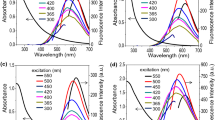Abstract
Fluorescent carbon nanoparticles exhibit merits in terms of photochemical stability, functional modification flexibility and excellent biocompatibility. Currently, fluorescent carbon nanoparticles are often obtained by bottom-up or up-bottom strategies. So far, there has been no literature concerning spontaneous formation of fluorescent carbon nanoparticles. However, we have successfully found that fluorescent carbon nanoparticles can form spontaneously in the glutaraldehyde solution. Then further investigations were conducted on the storage time, pH and temperature, which could affect the fluorescence intensity of glutaraldehyde solution. The results indicate that the value of the fluorescence intensity will increase with the extension of the storage time. Moreover, the fluorescence mechanism of the glutaraldehyde solution was studied according to its properties and experiment results. Transmission electron microscopy was used to demonstrate nanoparticles in the glutaraldehyde solution. It’s assumed that such phenomenon is probably attributed to the conjugated structure resulting from the polymerization of glutaraldehyde and the quantum confinement effect owing to the nanoparticles formed by the aggregation of polymers. Therefore, the spontaneous fluorescence produced by glutaraldehyde solution provides a simple and environmentally-friendly way to prepare fluorescent carbon nanoparticles.









Similar content being viewed by others
Data Availability
All data used to support the findings of this study are included in the article.
References
Neabo JR, Vigier-Carriere C, Rondeau-Gagne S, Morin JF (2012) Room-temperature synthesis of soluble, fluorescent carbon nanoparticles from organogel precursors. Chem Commun 48:10144–10146
Hu J, Yuan B, Zhang Y, Guo M (2015) Immobilization of laccase on magnetic silica nanoparticles and its application in the oxidation of guaiacol, a phenolic lignin model compound. Rsc Adv 5:99439–99447
Hu S, Ding Y, Chang Q, Trinchi A, Lin K, Yang J, Liu J (2015) Self-assembly of fluorescent carbon dots in a N, N-dimethylmethanamide solution via Schiff base reaction. Nanoscale 7:4372–4376
Yang Z-C, Li X, Wang J (2011) Intrinsically fluorescent nitrogen-containing carbon nanoparticles synthesized by a hydrothermal process. Carbon 49:5207–5212
Zhang Z, Xu S, Wu P (2015) H2O2-assisted hydrothermal process: a green, versatile route to synthesize size-controllable nitrogen-doped fluorescent carbon nanoparticles from natural macromolecules. Part Part Syst Charact 32:176–181
Huang CL, Huang CC, Mai FD, Yen CL, Tzing SH, Hsieh HT, Ling YC, Chang JY (2015) Application of paramagnetic graphene quantum dots as a platform for simultaneous dual-modality bioimaging and tumor-targeted drug delivery. J Mater Chem B3:651–664
Shehab M, Ebrahim S, Soliman M (2017) Graphene quantum dots prepared from glucose as optical sensor for glucose. J Lumin 184:110–116
David Tai-Wai C (2012) Mechanism and kinetics of the interaction of glutaraldehyde with collagen and model amine compounds. Int J Agric Technol 82:5996–6000
Walt DR, Agayn VI (1994) The chemistry of enzyme and protein immobilization with glutaraldehyde. Trac-Trend Anal Chem 13:425–430
Anderson PJ (1967) Purification and quantitation of glutaraldehyde and its effect on several enzyme activities in skeletal muscle. The journal of histochemistry cytochemistry: official journal of the Histochemistry Society 15:652–661
Hopwood D (1969) The elution patterns of formaldehyde, glutaraldehyde, glyoxal and α-hydroxyadipaldehyde from Sephadex G-10 and their significance for tissue fixation. Histochimie 20:127–132
Filachione EM, Fein ML, Harris EH Jr (1964)Technical Notes. Tanning with Glutaraldehyde, Jalca 59:281–292
Harris EHJ, Filachione EM (1975) Glutaraldehyde retannage of chrome leather. Effect of ambient storage on selected properties of the leather. J Am Leather Chem Assoc 70:269–272
Gorman SP, Scott EM, Russell AD (1980) Antimicrobial activity, uses and mechanism of action of glutaraldehyde. J Appl Bacteriol 48:161
Li S, Xiao D, Liu D, He H (2018) Calcium-doped fluorescent carbon nanoparticles: spontaneous thermal synthesis, pH-sensitive fluorescence off-on, and mechanism. Sensors Actuators B Chem 266:594–602
Rasmussen KE, Albrechtsen J (1974) Glutaraldehyde. The influence of pH, temperature, and buffering on the polymerization rate. Histochem Cell Biol 38:19–26
Tashima T, Imai M, Kuroda Y, Yagi S, Nakagawa T (1991) Structure of a new oligomer of glutaraldehyde produced by aldol condensation reaction. J Org Chem 56:694–697
Monsan P, Puzo G, Mazarguil H (1976) Étude du mécanisme d’établissement des liaisons glutaraldéhyde-protéines. Biochimie 57:1281–1292
Aso C, Aito Y (1962) Studies on the polymerization of bifunctional monomers. II. Polymerization of glutaraldehyde. Macromol Chem Phys 58:195–203
Aso C, Furuta A, Aito Y (2012) Studies on the polymerization of bifunctional monomers. VI. Cyclopolymerization of succinaldehyde. J Macromol Sci A Chem 5:167–180
Margel S, Rembaum A (1980) Synthesis and characterization of Poly(glutaraldehyde). A potential reagent for protein immobilization and cell separation. Macromolecules 13:19–24
Chen C, Park C, Boudouris BW, Horng J, Geng B, Girit C, Zettl A, Crommie MF, Segaman RA, Louie SG, Wang F (2011) Controlling inelastic light scattering quantum pathways in graphene. Nature 471:617–620
Funding
This work was supported by the National Natural Science Foundation of China (Grant No. 81402899), and the Key Research & Development Program of Shandong Province (2018GGX109006).
Author information
Authors and Affiliations
Contributions
Pengli Zuo and Jingyu Zhang performed the experiments and analyzed the data; Yuqing Zhou repeated the experiments; Ningjie Xie wrote the original draft and all authors commented on previous versions of the manuscript; Deli Xiao designed the whole experiments, reviewed and edited this manuscript.
Corresponding author
Ethics declarations
Conflict of Interest
There are no conflicts to declare.
Code Availability
Not applicable.
Additional information
Publisher’s Note
Springer Nature remains neutral with regard to jurisdictional claims in published maps and institutional affiliations.
Rights and permissions
About this article
Cite this article
Zuo, P., Zhang, J., Zhou, Y. et al. Spontaneous Formation of Fluorescent Carbon Nanoparticles in Glutaraldehyde Solution and Their Fluorescence Mechanism. J Fluoresc 31, 509–516 (2021). https://doi.org/10.1007/s10895-020-02678-w
Received:
Accepted:
Published:
Issue Date:
DOI: https://doi.org/10.1007/s10895-020-02678-w




